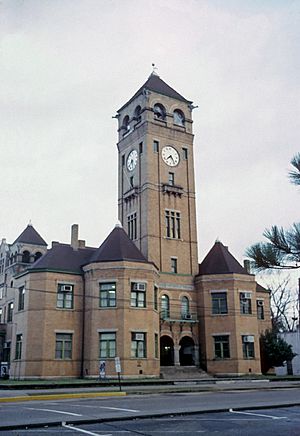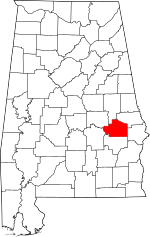Macon County, Alabama facts for kids
Quick facts for kids
Macon County
|
|||
|---|---|---|---|

|
|||
|
|||

Location within the U.S. state of Alabama
|
|||
 Alabama's location within the U.S. |
|||
| Country | |||
| State | |||
| Founded | December 18, 1832 | ||
| Named for | Nathaniel Macon | ||
| Seat | Tuskegee | ||
| Largest city | Tuskegee | ||
| Area | |||
| • Total | 613 sq mi (1,590 km2) | ||
| • Land | 609 sq mi (1,580 km2) | ||
| • Water | 4.3 sq mi (11 km2) 0.7% | ||
| Population
(2020)
|
|||
| • Total | 19,532 | ||
| • Estimate
(2023)
|
18,370 |
||
| • Density | 31.863/sq mi (12.302/km2) | ||
| Time zone | UTC−6 (Central) | ||
| • Summer (DST) | UTC−5 (CDT) | ||
| Congressional district | 3rd | ||
|
|||
Macon County is a county in the east central part of Alabama. As of the 2020 census, about 19,532 people live there. The main town and county seat is Tuskegee. The county is named after Nathaniel Macon. He was a important member of the United States Senate from North Carolina.
In the 1800s, the county was known for its large cotton farms. These farms were called plantations. Many enslaved people were forced to work on these farms. Because of this history, the county is part of the "Black Belt" region. It has had a majority of Black residents for a long time.
Contents
History of Macon County
For thousands of years, different groups of indigenous peoples lived in this area. When Europeans arrived, they met the Creek people. The Creek were descendants of the ancient Mississippian culture.
Macon County was created on December 18, 1832. This happened after the Creek people gave up their land. The US Congress passed the Indian Removal Act in 1830. This law forced many Native American groups, including the Creek, to move. They had to go to Indian Territory west of the Mississippi River.
New settlers came to the area. They brought enslaved people with them. These enslaved people were forced to work on large cotton plantations.
In the early 1900s, many African Americans left the county. This was part of the Great Migration. They moved to big cities in the North and Midwest. They hoped to find better jobs and escape unfair laws. The population of Macon County has dropped since 1950.
Macon County is famous for Tuskegee University. This historic university was founded by Booker T. Washington. It was first known as Tuskegee Institute.
Geography
Macon County covers about 613 square miles. Most of this area, 609 square miles, is land. Only a small part, about 4.3 square miles, is water.
Major Roads
 Interstate 85
Interstate 85 U.S. Highway 29
U.S. Highway 29 U.S. Highway 80
U.S. Highway 80 State Route 14
State Route 14 State Route 49
State Route 49 State Route 81
State Route 81 State Route 138
State Route 138 State Route 186
State Route 186 State Route 199
State Route 199 State Route 229
State Route 229
Neighboring Counties
- Tallapoosa County (north)
- Lee County (northeast)
- Russell County (southeast)
- Bullock County (south)
- Montgomery County (southwest)
- Elmore County (northwest)
Protected Natural Areas
- Tuskegee Airmen National Historic Site
- Tuskegee Institute National Historic Site
- The George Washington Carver Museum
- Tuskegee National Forest
Railroads
- CSX A&WP Subdivision
- Former Seaboard Line (no longer used)
Population Information
| Historical population | |||
|---|---|---|---|
| Census | Pop. | %± | |
| 1840 | 11,247 | — | |
| 1850 | 26,898 | 139.2% | |
| 1860 | 26,802 | −0.4% | |
| 1870 | 17,727 | −33.9% | |
| 1880 | 17,371 | −2.0% | |
| 1890 | 18,439 | 6.1% | |
| 1900 | 23,126 | 25.4% | |
| 1910 | 26,049 | 12.6% | |
| 1920 | 23,561 | −9.6% | |
| 1930 | 27,103 | 15.0% | |
| 1940 | 27,654 | 2.0% | |
| 1950 | 30,561 | 10.5% | |
| 1960 | 26,717 | −12.6% | |
| 1970 | 24,841 | −7.0% | |
| 1980 | 26,829 | 8.0% | |
| 1990 | 24,928 | −7.1% | |
| 2000 | 24,105 | −3.3% | |
| 2010 | 21,452 | −11.0% | |
| 2020 | 19,532 | −9.0% | |
| 2023 (est.) | 18,370 | −14.4% | |
| U.S. Decennial Census 1790–1960 1900–1990 1990–2000 2010–2020 |
|||
2020 Census Data
This table shows the different groups of people living in Macon County.
| Race / Ethnicity (NH = Non-Hispanic) | Pop 2000 | Pop 2010 | Pop 2020 | % 2000 | % 2010 | % 2020 |
|---|---|---|---|---|---|---|
| White alone (NH) | 3,331 | 3,267 | 3,187 | 13.82% | 15.23% | 16.32% |
| Black or African American alone (NH) | 20,298 | 17,631 | 15,395 | 84.21% | 82.19% | 78.82% |
| Native American or Alaska Native alone (NH) | 39 | 28 | 48 | 0.16% | 0.13% | 0.25% |
| Asian alone (NH) | 91 | 76 | 74 | 0.38% | 0.35% | 0.38% |
| Pacific Islander alone (NH) | 1 | 2 | 4 | 0.00% | 0.01% | 0.02% |
| Other race alone (NH) | 10 | 12 | 45 | 0.04% | 0.06% | 0.23% |
| Mixed race or Multiracial (NH) | 162 | 204 | 418 | 0.67% | 0.95% | 2.14% |
| Hispanic or Latino (any race) | 173 | 232 | 361 | 0.72% | 1.08% | 1.85% |
| Total | 24,105 | 21,452 | 19,532 | 100.00% | 100.00% | 100.00% |
In 2020, there were 19,532 people living in Macon County. There were 7,474 households. Also, there were 4,279 families.
2010 Census Data
In 2010, there were 21,452 people in the county. About 82.6% were Black or African American. Around 15.5% were White. About 0.4% were Asian. A small number, 0.1%, were Native American. About 0.3% were of another race. And 1.1% were of two or more races. About 1.1% of the people were Hispanic or Latino.
Communities
Macon County has one city and several towns and small communities.
City
- Tuskegee (This is the main town, or county seat)
Towns
- Franklin
- Notasulga (partly in Lee County)
- Shorter
Unincorporated Communities
These are smaller places that are not officially towns or cities.
- Boromville
- Creek Stand
- Cross Keys
- Fort Davis
- Hardaway
- Little Texas
- Milstead
- Society Hill
- Warriorstand
Places to Visit
Macon County has many interesting places to visit.
- Tuskegee University: A famous university with a rich history.
- Tuskegee National Forest: A beautiful forest for outdoor activities.
- Tuskegee Lake: A lake where you can enjoy nature.
- Tuskegee Human and Civil Rights Museum: Learn about human rights and civil rights history.
- Moton Field: This was the training site for the Tuskegee Airmen. They were brave African American pilots.
See also
 In Spanish: Condado de Macon (Alabama) para niños
In Spanish: Condado de Macon (Alabama) para niños



